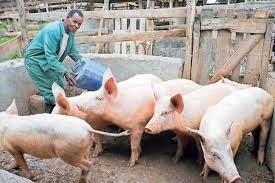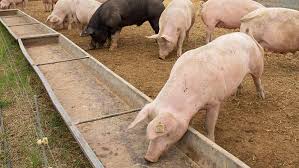Pigs, like humans, can eat a variety of foods of both animal and vegetable origin. Although they accept most foods, the quality of their diet is crucial for their health and productivity. Pigs will not thrive on grazing and fibrous feed alone. To ensure good health and optimal production, pigs require adequate amounts of high-quality feed.
Nutrition and feeding management are essential aspects of swine production. Swine producers must understand the nutrient requirements of pigs at different life stages, the types of feedstuffs suitable for swine, and effective feeding management strategies for economic production.
Unfortunately, many swine farmers keep pigs in poor conditions, limiting profitability. Swine are particularly vulnerable to dirty, drafty housing, which can cause illness, and poor feeding practices. The essential nutrient groups for pigs include energy, protein, minerals, vitamins, and water.
Read Also: Various Types Of Fruits And Their Nutritional Value
Nutritional Requirements of Swine

1. Water
Water is one of the most important nutrients. Swine of all ages should have free access to fresh and clean water at all times. Pigs drink approximately two to five times the amount of feed they consume, depending on the moisture content of the feed. When under stress due to heat or disease, pigs may stop eating but will require extra water.
A lactating sow with 10 piglets needs at least 25 liters of water daily. Drinking pans or troughs should be cleaned daily, while modern drinking nipples should be checked regularly to ensure proper functioning.
Restricting water intake can reduce growth rates, feed efficiency, and milk production in lactating sows. Severe water deprivation can be fatal. Water requirements are influenced by factors such as environmental temperature, humidity, feed composition, and pig weight.
Water Requirement per Kilogram of Feed (Liters):
i. Fattening pigs: 2.5
ii. Lactating sows: 5.0
iii. Dry sows: 3.0
iv. Piglets: Ad-libitum (freely as needed)
2. Energy
Apart from water, energy is the most critical nutrient for pigs, as it directly affects survival and productivity. Energy is measured in heat units, traditionally as calories, but now commonly in megajoules (MJ), where 1 MJ = 0.239 MCal.
Nursing pigs derive most of their energy from fat and lactose sugar in milk, while growing pigs rely on starch metabolism due to limited amylase enzyme activity in the small intestine.
Energy requirements in pigs vary based on weight, genetic growth potential, and environmental conditions. The maintenance energy requirement is related to metabolic body weight and is approximately 110 kcal of digestible energy per kilogram of body weight. Common energy-rich feeds include maize, rice, sorghum, cassava, sweet potatoes, and cereal grains.
Assessing energy adequacy involves observing pig body condition. Excess energy results in fat storage, while energy deficiency leads to thin pigs with low productivity. However, overly fat reproductive sows may experience decreased productivity.
3. Protein
Protein is composed of approximately 20 amino acids, nine of which pigs cannot synthesize and must obtain from their diet. A high-quality protein source provides essential amino acids in the right proportions for growth, reproduction, and lactation.
Protein-rich feed includes oilseeds (cottonseed, soybean, groundnuts, coconut), beans, peas, blood meal, and fishmeal. The protein requirement increases with pig weight and age.
Protein is essential for growth, breeding, and milk production. Since all organs, muscles, and enzymes are made of protein, both the quality and quantity of dietary protein are crucial.
Animal-based protein sources, such as fishmeal, milk, or meat meal, provide the highest-quality protein and are especially beneficial for young pigs. Plant-based protein by-products, such as soybean meal or groundnut cake, also serve as good sources, but cereals alone lack sufficient protein.
4. Minerals
Compared to energy and protein, minerals are required in smaller amounts. Swine diets must include 13 essential minerals, with major minerals being calcium, phosphorus, sodium, magnesium, and choline, while trace minerals include iron, iodine, and selenium. Calcium and phosphorus are needed in the greatest amounts for strong skeletal development.
5. Vitamins
Vitamins are organic compounds that function in small amounts and are vital for normal body functions. Pigs require 14 essential vitamins, classified into fat-soluble vitamins (A, D, E, and K) and water-soluble vitamins (C and B-complex, including riboflavin, niacin, vitamin B12, and folic acid). Cereal grains and plant protein supplements are poor sources of many vitamins; therefore, commercial vitamin premixes should be added to swine diets.
Read Also: Cultivation Methods For Different Fruit Trees And Bushes
Feeding Management in Swine Production

Pigs, unlike ruminants, struggle to digest crude fiber due to their simple stomachs. When foraging, they prefer succulent parts of roughage and supplement their diet with roots, tubers, worms, and insects. However, in pig farming, daily feed provision is essential for optimal productivity.
Pigs should be fed twice daily at consistent times, with quality feed to ensure strength and productivity. Young piglets require the highest-quality feed, especially after weaning. Lactating sows must receive adequate nutrition to support milk production.
The condition of a lactating sow indicates whether she is receiving sufficient feed. Poor nutrition results in small litters and delayed reproductive cycles.
For optimal nutrition, feed types must match the pig’s age and production stage. Commercial feed factories typically produce at least five feed types:
1. Sow feed: Two types: one for pregnancy and another for lactation. Pregnant sows can receive lower-quality feed with added ingredients like rice bran.
2. Creep feed 1: Highest-quality feed for piglets, starting from 7-10 days old.
3. Creep feed 2: Given to piglets from two weeks after weaning.
4. Starter feed: For pigs over 20 kg until they reach 35-40 kg.
5. Fattener feed: For pigs over 40 kg, preparing them for slaughter.
1. Feeding Pregnant Sows and Gilts
Until their first mating, gilts require high-quality feed similar to lactating sows. Daily feed intake should be 1.5-2.5 kg, with an extra 0.5 kg given before mating to increase embryo count. During early pregnancy, feed should be limited to 1.5-2.5 kg per day, adjusting based on body condition. In the last pregnancy month, feed should be increased to 2.5-3.0 kg per day. A few days before farrowing, feed should be gradually reduced.
2. Feeding Lactating Sows
After farrowing, lactating sows require abundant drinking water. A sow with 10 piglets needs 30-35 liters of water per day. Feed intake starts at 2 kg daily after farrowing and gradually increases by 0.5 kg daily for 10 days. Maximum feed intake is 1.5 kg for maintenance + 0.5 kg per piglet. High temperatures can reduce feed consumption, so high-quality feed is essential. On the day of weaning, feed is reduced to 0-0.5 kg to stop milk flow.
3. Feeding Weaned Piglets and Growing Pigs
Piglets need colostrum immediately after birth for warmth, energy, and immunity. Weaning before six weeks is not ideal, but for commercial purposes, it is often done at four weeks.
From three weeks old, piglets benefit from supplementary feed containing animal protein and digestible starch. Post-weaning, maintaining the same feed for at least 10 days reduces digestive issues.
Young pigs (20-45 kg) should receive 1.0-1.8 kg of starter feed per day. Older pigs (>40 kg) can tolerate lower-quality feed but require monitoring to prevent excessive fat accumulation before slaughter.
Do you have any questions, suggestions, or contributions? If so, please feel free to use the comment box below to share your thoughts. We also encourage you to kindly share this information with others who might benefit from it. Since we can’t reach everyone at once, we truly appreciate your help in spreading the word. Thank you so much for your support and for sharing!

